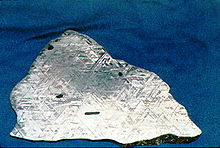- Count Alois von Beckh Widmanstätten
-
Count Alois von Beckh Widmanstätten (July 13, 1753–June 10, 1849) was an Austrian printer and scientist. His name is sometimes given as Alois von Beckh-Widmannstätten or Aloys Beck, Edler von Widmannstätten.
Contents
Working life
During his youth he was trained in the printing art by his father. His family owned exclusive printing rights in the Steiermark province, but this was lost in 1784 and Alois sold the business in 1807. In 1804 he ran a spinning mill in Pottendorf, Austria.
Starting in 1807 he was placed in charge of the Fabriksproduktenkabinett, a private collection of technology owned by the Emperor. In 1808 he was the director of the Imperial Porcelain works in Vienna.
Widmanstätten patterns discovery
In 1808 he independently discovered some amazing patterns, now called Widmanstätten patterns in iron meteorites, by flame heating a slab of Hraschina meteorite.[1][2] The different iron alloys of meteorites oxidized at different rates during heating, causing color and luster differences. He did not publish his discovery, but claimed it only through oral communication. Nevertheless, he received full credit for it, and Carl von Schreibers, director of the Vienna Mineral and Zoology Cabinet, named the structure after Widmanstätten.[3]
It is a little-known fact that the actually discoverer of Widmanstätten pattern was G. Thomson. In fact, during the period he spent in Naples, he discovered these figures bathing a Krasnojarsk meteorite in nitric acid with the purpose of removing rust. 1804 he published the discovery in French on the Bibliothèque Britannique,[3][4][5] so the full credit of the discovery should be assigned to G. Thomson due to chronological priority.[3][4][6]
Named after him
- Widmanstätten patterns of iron meteorites
- The crater Widmannstätten on the Moon
- 21564 Widmanstätten asteroid
Notes
- ^ Meteoritics & planetary science: Volume 42, Ed. 9-12. Meteoritical Society at the University of Arkansas, Department of Chemistry and Biochemistry, 2007
- ^ O. Richard Norton. Rocks from Space: Meteorites and Meteorite Hunters. Mountain Press Pub. (1998) ISBN 0878423737
- ^ a b c John G. Burke. Cosmic Debris: Meteorites in History. University of California Press, 1986. ISBN 0520056515
- ^ a b Gian Battista Vai, W. Glen E. Caldwell. The origins of geology in Italy. Geological Society of America, 2006, ISBN 0813724112 [1]
- ^ F. A. Paneth. The discovery and earliest reproductions of the Widmanstatten figures. Geochimica et Cosmochimica Acta, 1960, 18, pp.176-182
- ^ O. Richard Norton. The Cambridge encyclopedia of meteorites. Cambridge, Cambridge University Press, 2002. ISBN 0521621437.
See also
Other projects
Categories:- 1753 births
- 1849 deaths
- Austrian scientists
- Austrian scientist stubs
Wikimedia Foundation. 2010.

